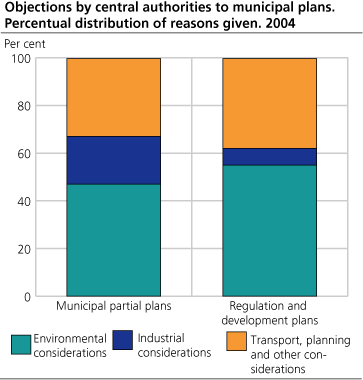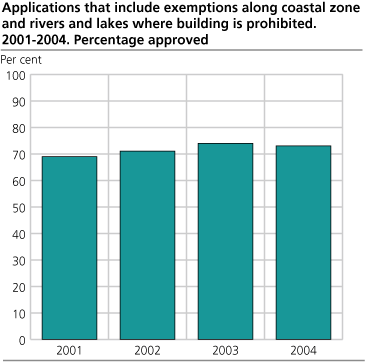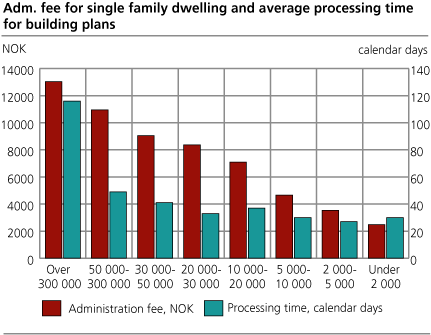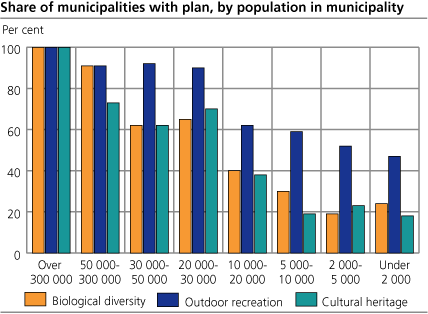Content
Published:
This is an archived release.
Environmental considerations neglected in municipal plans?
The central authorities made objections to 17 per cent of all municipal plans sent for external consultation in 2004. More than half of the objections were due to environmental considerations.
Norwegian municipalities have a vital impact on the protection and management of the environment through the administration of the Planning and Building Act. To ensure national interests, the central authorities may forward objections to municipal plans if they are in conflict with national interests.
In 2004, Norwegian municipalities sent 249 municipal partial plans and 2804 regulation and development plans for external consultation, of which objections were made to 33 per cent of the partial plans and 16 per cent of the regulation and development plans. 53 per cent the objections were due to environmental considerations (figure 1 and table 9). One third of the objections were due to transport, planning and other considerations, while the rest were due to industrial considerations, of which agriculture and forestry dominated.
These results may indicate that the responsibility for national environmental goals only to a small extent is delegated to the municipalities, although the municipalities have a strong impact on environmental goals through the Planning and Building Act.
Majority still granted exemptions in coastal zone and along rivers and lakes
73 per cent of all building project applications in the coastal zone and along rivers and lakes were granted exemption (figure 2 and table 1) in 2004. The statistics only include exemptions for new buildings. The high level of approval is partly due to the practice in some municipalities, where likely rejections are signalled in preliminary negotiations. Such rejections are not included in the statistics. The general ban on building developments in the coastal zone does not apply in areas regulated for development. Therefore, the number of exemptions does not provide the full picture of the level of development in the coastal zone (see also Development in the coastal zone ).
Biological diversity, recreation and cultural heritage in municipal land-use planning
A municipality uses the land-use part of the municipal master plan as the basis for safeguarding areas of special value. This can be done in various ways, for example by adopting plans with a special focus on environmental assets such as biological diversity, outdoor recreation and cultural heritage. The municipalities place greatest emphasis on outdoor recreation, as 60 per cent had plans for safeguarding this interest in 2004. Cultural heritage and biological diversity do not seem to be equally important, as only 30 per cent of municipalities had plans for these areas (table 7). However, the number of municipalities with plans for biological diversity has increased sharply from 17 per cent in 2001 to 32 per cent in 2004.
The decisive factor underlying these differences may be the municipalities' perception of their areas of responsibility. Classic nature and cultural heritage conservation have traditionally been regarded as a central government responsibility, whereas outdoor recreation to a greater extent has been delegated to local government.
See also:
Development in the coastal zone .
Local environmental efforts in municipalities and county authorities, 2004
Tables:
- Table 1 Building project applications in areas of particular environmental value
- Table 2 Average processing time and administration fee for regulation plans, building plans and subdivision of land including survey. By inhabitants in the municipality
- Table 3 Case load of regulation plans, building plans and subdivision of land including survey. Weighted average
- Table 4 Share of municipalities with plan for biological diversity, outdoor recreation and preservation of cultural heritage. Average age of plans in the year of reporting
- Table 5 Municipal expenses, revenues and investments within land use planning (function 300)
- Table 6 Applications for exemptions relating to the cultural heritage act and the planning and building act
- Table 7 Number of county authorities with existing plan for different topics. Average age of the plans in the year of reporting
- Table 8 Gross operating expenses, operating revenues and investments in local and regional development - area and nature (function 715). County authorities. 1000 NOK
- Table 9 Objections by central authorities to municipal plans. Reasons for objections given. 2004
Find more figures
Find detailed figures from Town and country planning in municipalities and county authorities
Contact
-
Ingeborg Hauge
E-mail: ingeborg.hauge@ssb.no
tel.: (+47) 95 87 66 56
-
Jørn Kristian Undelstvedt
E-mail: jorn.kristian.undelstvedt@ssb.no
tel.: (+47) 94 50 68 64




